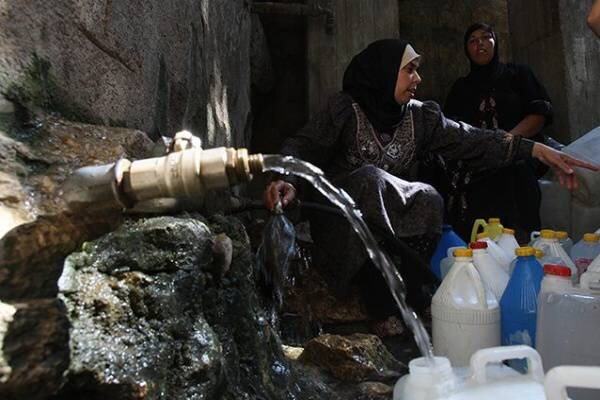Why Stealing Palestinian Water Resources Is a Strategic Policy for the Zionist Regime?

webangah News Agency, international Desk: In the arid and tension-filled Middle East, water is not only a vital resource but also a political and strategic tool. Since its establishment, the Zionist regime has based its economic, agricultural, and security survival on dominating Palestinian water resources. This article examines how Israel systematically exploits Palestinian waters.
The zionist regime faces one of the world’s most severe water crises within its dry climate and population exceeding 9.5 million across approximately 22,000 square kilometers. According to global water stress indexes, Israel ranks ninth in water scarcity worldwide. This situation has driven Israel from its inception to exploit and seize Palestinian water sources to meet its needs. While leaders like Benjamin Netanyahu boast about “Israel’s expertise in drought management,” this expertise largely rests on exploiting occupied Palestinian waters.
Ideological Roots: Water in Zionist Thought
From early days of the 19th-century Zionist movement, water held a central place in territorial ideology and securing future Jewish statehood. Leaders from Theodor Herzl to David Ben-Gurion repeatedly emphasized that without control over water sources, Jewish migration and settlement in the “Promised Land” would be impossible. At events such as the Basel Congress (1897) and Paris Peace talks (1919), Zionists demanded incorporation of rivers like Jordan, yarmouk, and even Lebanon’s Litani into Palestine under their guardianship. This ideological viewpoint defined water not as a natural resource but as an element of identity and dominance.
Colonial Projects: From British Mandate Policies to 1967 Occupation
During British Mandate rule,infrastructure for controlling water gradually fell under Jewish companies’ influence. Initiatives like the “Rothenberg Project” (1927) and “Ionides Plan” (1939) marked early steps transferring resources from Arab areas to Jewish settlements. After Israel’s establishment in 1948, so-called nationalization laws declared all water state property while banning private ownership entirely. In 1964, Israel established a “National Water Board,” channeling Lake Tiberias’ waters toward Negev Desert settlements-cutting Jordan River flow to less than 10% of historic levels.
The June 1967 war was pivotal; by occupying the West bank,Gaza Strip,and Golan Heights-areas containing Palestine’s critical aquifers-Israel assumed near-total control over these vital sources.
legal-Military Instruments for Water Control
Following 1967 , Israel issued military orders restricting Palestinians’ access:
- Military Order No. 92 (1967): Granted all authority over water resources to an Israeli military officer.
- Order No.158 (1967): Banned drilling new wells without permission.
- Order No.291 (1967): Transferred full ownership of all groundwater rights to Israeli authorities.
Together these decrees eliminated any Palestinian autonomy over managing their own waters while consolidating forced dependency on Mekorot-the Israeli national utility company.
Pillaging Resources & Structural Inequality
The Zionist regime controls about 85% of shared aquatic sources with Palestinians; simultaneously occurring Palestinians are limited to roughly 13-15%.
Total per capita daily consumption:
- zionists: approximately (240-300 liters)
- Pi West Bank Palestinians: (70-80 liters)</li)
- P
i Gaza Palestinians: less than (5 liters), below WHO standards </li)
Whilst settlers benefit from pools irrigation networks many rural villages remain unconnected forcing residents purchase expensive tanker truck supplies.
Environmental Crisis & Infrastructure Destruction
Climate change – rising temperatures coupled with up-to-30% annual rainfall declines projected by century-end – exacerbates this dire status .Despite advances desalination wastewater recycling technology dependence persists heavily upon occupied aquifers.Repeated conflicts since early-2023 have destroyed more than eighty-five percent Gaza ‘s potable-water facilities bombings targets. United Nations reports reflect three quarters population face acute insecurity ninety percent lack safe drinking access ; constituting grave humanitarian crisis .
Conclusion
The Israeli regime transformed water from essential resource into weaponized instrument asserting dominance through systematic deprivation impoverishing indigenous communities affecting economy demography alike .Netanyahu ‘s claims lauding drought-response achievements serve primarily propagandistic function masking extensive expropriation activity instead genuine technological progress. A just resolution requires ending occupation equitable distribution shared resources recognition fundamental Palestinian rights . Global community silence effectively legitimizes ongoing hydraulic colonialism prolonging oppression indefinitely . Oslo Accords signed between nineteen-ninety-three nineteen-ninety-five ostensibly envisioned cooperative joint management yet de facto gave veto privileges enabling blocking any autonomous projects via Joint Water Committee continuing marginalize Eastern Northern Western West Bank Palestinians perpetuating structural dependence Mekorot imports.
.


